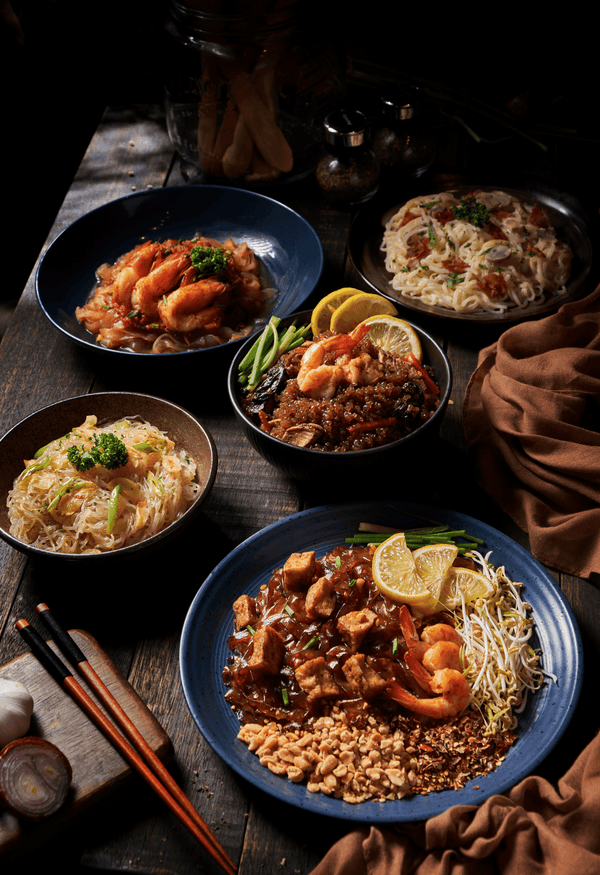Your Cart is Empty
November 27, 2021
If one were to trace the origins of the noodle, they would end up in the largest of all Asian countries - China. Noodles are one of the most important traditional staple foods in Asia. Typically made from unleavened wheat dough and are stretched, extruded, or rolled, and then cut into varying shapes, noodles account for approximately 20%–50% of the total wheat consumption in Asia. The noodle has the capability to adequately reflect the history, regional differences, social changes, traditional values and cultural identity of China.
Zha jiang mian is a specialty of Beijing. These “fried sauce noodles” from the Shandong province are made with chewy, thick wheat noodles and topped with zha jiang sauce, a rich mixture of ground pork and fermented soybean paste. Along with dan dan mian, dao xiao mian, and beef noodles, these constitute some of today’s signature Chinese noodles.
The History
Noodles have been closely interwoven into the Chinese society and their culinary practices for the longest time. A 4,000-year-old bowl of noodles unearthed in China is the earliest evidence ever found of one of the world's most popular foods, indicating an Asian origin for the staple dish. The earliest Chinese noodles were shaped into little bits, formed with bread dough and are called mian pian. This type of noodle still exists today in China. Based on old poetry from 300 BCE, written by poet Shu Shi, we see that noodles have been a staple fixture in Chinese homes at that time.
By the time of the Han Dynasty in early 200AD, noodles were present all over Chinese culture. It was commonly known as cake or gao, and appeared as sheets or strips. With time, Chinese noodles started being made with wheat flour, rice flour and sometimes mung bean starch. By the Song Dynasty (960-1279 AD), we saw the emergence of noodle shops at all major Chinese cities, and eventually it spread to Korea, Japan, and other Southeast Asian countries through Chinese influence.
The Significance of Noodles
Noodles are still a big part of Asian cultural celebrations and festivals today. Chinese people have many customs, which essentially reinforce “human nature” and “worldly common sense” in the symbolic meaning of noodles. Noodles hold a unique value of traditional culture.
Noodles are a symbol of longevity in Chinese culture. They are as much a part of a Chinese birthday celebration as a birthday cake with lit candles is in many countries. Since noodles symbolise longevity, it is considered very unlucky to cut up a strand. For newlyweds who are moving into their first home, noodles with gravy symbolises a “flavoured life”. To anticipate good weather on Lunar New Year, they feast on dragon whiskers noodles.
Historically sold on the streets of Sichuan, dan dan mian also has a rich story to tell. These noodles have derived their name due to its history of peddlers carrying the pots and stoves on their shoulders using a bamboo pole (dan) in order to sell the noodles. This story is used as a life lesson to teach children about the importance of hard work and good service, and the role they play in becoming prosperous.
The Evolution
Through its integral role in food culture and what it symbolises, it is evident that noodles have come a long way since its origin, with signature dishes influenced from different regions in China.
However, even with traditional dishes still present, we also see that there has been an evolution in the way noodles are being made in modern times. Through creativity and hard work, we see many variations of noodle dishes today, such as ramen noodles and instant noodles.
For those who are looking for an alternative, “new age” noodles to add to your shelf, AMAZING LOKARB™ may be the choice for you. High quality and low in carbohydrates, AMAZING LOKARB™ shirataki noodles has many unique attributes and is beneficial for health.
Visit our site to find out more today!Also in Blog

Is Childhood Obesity Really a Thing?
November 29, 2021
Childhood obesity has been a prevalent issue in Singapore for the past two decades. In 2016, the obesity rate among children who are schooling locally stood at 12%. According to a survey conducted by the National Population Health in 2017, the proportion of overweight children in mainstream schools had increased from 11% in 2013 to 13% in 2017. This number has remained on an upward trajectory since – and it is concerning.

4 Reasons Why There's An Obesity Epidemic
November 21, 2021
According to the World Health Organization (WHO), global obesity rates have tripled since 1975. During the year 2016, more than 1.9 billion adults were overweight. Out of them, nearly 650 million were obese, but why is 47 percent of the United States population expected to be obese by 2030?

Diabetic Diet: What to Eat & What to Avoid
November 16, 2021
It is said that diabetes works like termites – it causes slow, hidden, but significant damage in the body. Therefore healthy eating for diabetics is not a luxury but an absolute necessity. A diet low in carbohydrates can help people with diabetes manage their sugar levels and also reverse some other effects of diabetes like heart disease and weight gain.
Recent Articles
- Is Childhood Obesity Really a Thing? November 29, 2021
- The History of Chinese Noodles in Asia November 27, 2021
- 4 Reasons Why There's An Obesity Epidemic November 21, 2021
- Diabetic Diet: What to Eat & What to Avoid November 16, 2021
- Are There Good and Bad Carbohydrates? November 10, 2021
What's Your Story?
We love inspiring stories of people who have made healthy and positive changes in their lives. Share your story on Instagram and tag us #amazing_lokarb to win free box of noodles!
newsletter signup
Be the first to know about upcoming sales and promos. Get a 10% discount coupon when you subscribe!


